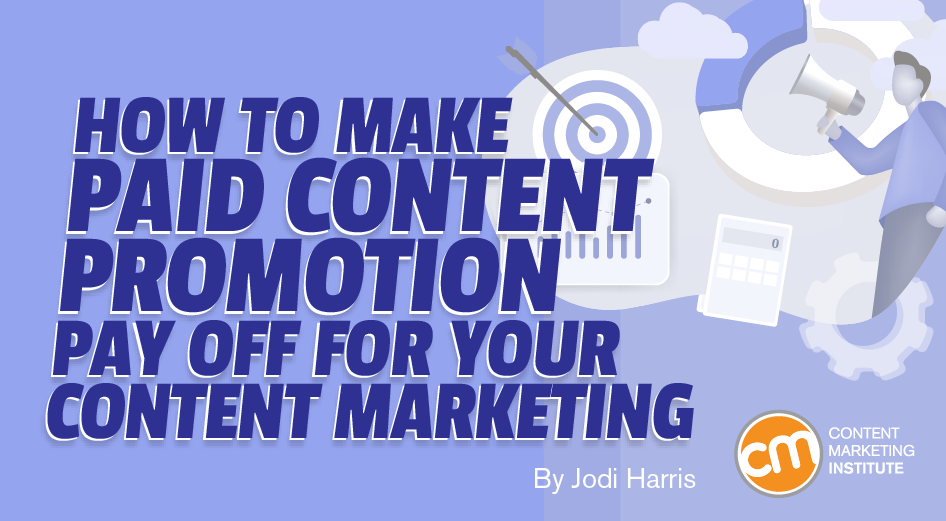
Updated April 14, 2022
No brand exists in a vacuum. To thrive and grow, it needs a constant influx of supporters who buy into its perspectives, points, and purposes and customers who buy its products.
A non-vacuum existence is the very reason marketing was invented – to draw interest by disseminating information about a brand’s favorable attributes, build desire for its products and services, and provide a clear pathway to make a purchase.
High-quality, high-value content can help achieve those goals on its own. But online noise and distractions, declining organic reach on social media, and ongoing shifts in search trends, getting that content seen and clicked often requires paid promotion.
Getting your #content seen and clicked often requires paid promotion, says @joderama via @CMIContent. Click To Tweet
You promote your content using traditional techniques – banner ads and paid placements – just as you would for a product or service. But content marketers can also take advantage of more strategic and authentic paid media approaches.
This overview offers some help, outlining paid promotion options like native advertising, paid search, influencer marketing, as well as Facebook, Twitter, LinkedIn, YouTube, TikTok, and Snapchat.
What is native advertising?
Native advertising is a third-party distribution format where the paid content matches the form, feel, function, topics, and quality of the content on the third-party site. The intent of the ad is not to disrupt the experience a reader would expect to find on that publisher’s site. Native ads support brand or direct-response goals.
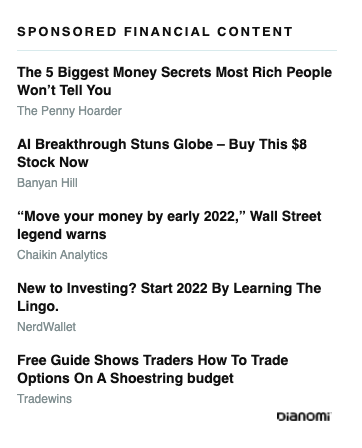
Brands like Penny Hoarder and Banyan Hill use native advertising to promote its content on Business Insider.
Why it works
You can reach an audience beyond your brand’s owned media channels who may be interested but unaware of your content. This technique positions content as useful, relevant information, making it less likely to encounter ad blockers and “banner blindness” and more likely to be trusted.
How to work it
To benefit from native advertising’s traffic-boosting effect, carefully select the content and the sites where you publish it. It also should speak to that audience’s pain points – not to go for the hard sell – so it will be recognized as valuable and not useless fluff.
Native advertising often is done through networks that will publish your ads on multiple sites. Before signing an agreement, make sure the target audience complements your own – why pay to reach the same audience twice or engage people who aren’t likely to share your brand’s interests or recognize its value?
Before signing an #NativeAdvertising agreement, make sure the target audience complements your own, says @joderama via @CMIContent. Click To Tweet
You also need to consider transparency issues. Make sure the content is clearly labeled as native advertising in some way so the ads don’t fall afoul of the U.S. Federal Trade Commission guidelines. It’s also the right thing to do from an ethical standpoint – you don’t want your brand to be accused of propagating “fake news,” do you?
What is paid search?
Search engine marketing (SEM) or paid search involves purchasing ads or sponsored listings on relevant search engine results pages (SERPs). While it may seem like a simple, straightforward concept, it’s a deceptively complicated technique to master. It involves keyword targeting, platform-specific display variations, ongoing algorithm changes, and a highly noisy and competitive marketplace for popular phrases.
The paid text-based listings get bumped to the top of the SERP and tagged to denote it’s a paid spot.
Paid text-based search listings get bumped to the top of the rankings page and tagged as a paid placement, says @joderma via @CMIContent. Click To Tweet
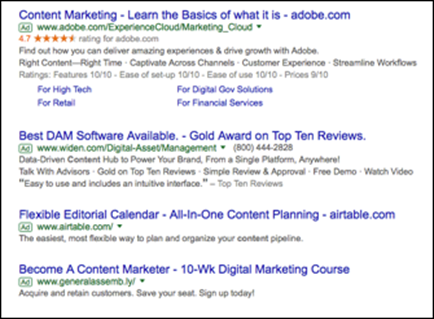
Paid search ads display at the top of a Google SERP, typically above organic listings. Adobe, Widen, Airtable, and General Assembly use paid search ads to put their content atop the ranking results for the term “content marketing.”
Why it works
Almost everyone uses search engines daily – often dozens of times a day. (Why do you think “Google it” has become the ubiquitous term for looking up a piece of information?). Paid search makes sense given the decline in organic links and the prominent role of the first page in attracting clicks.
How to work it
Google’s search ads run on a pay-per-click (PPC) basis. It uses an auction-based system to determine when and how often your ad is displayed alongside the targeted keywords. You should have a working knowledge of Google’s Ads. The system lets you choose a campaign type, create the ad copy, landing page URL, and calls to action, select target keywords and audience segments, and establish a budget, goals, and bid strategy for each campaign.
Setting a budget and maximum PPC informs your bidding process. Google’s algorithm evaluates your campaign against competitors targeting the same keyword (including their budget and PPC max). Then, it determines when and how often to display your ad.
Of course, success can be elusive and fleeting as searchers adjust their clicking behavior because they suspect paid links won’t be as helpful as organic links. This means it’s critical to do your homework before venturing into the wonderful world of the Google Ads auction (or the similar ad-buying processes offered by Bing and other search engines).
What is influencer marketing?
Influencer marketing programs enlist popular voices in your industry – people who have the ear of your target audience – to bring your content to their audience’s attention. Influencer involvement can be simple, like regularly retweeting your content to their communities, or more involved, like co-producing content for collaborative publication.
Though this technique can be leveraged on a non-paid basis, many high-profile influencers and celebrities and those with whom you want to establish a consistent, long-term partnership will likely expect to be compensated for the arrangement.
Why it works
Influencers’ audiences are receptive to their ideas and recommendations. Thus, influencers are well-positioned to amplify your content’s reach and awareness, which helps your content get found and consumed by the right audience. They can also lend credibility as their audience trusts the influencer to publish only valuable and relevant content.
How to work it
All influencer marketing requires logistical legwork to get your program off the ground. Here’s a rundown of the basic process:
- Become familiar with the notable voices in your industry and related social communities to identify influencers to speak on your content’s behalf.
- Vet potential partners to identify those who align well with your brand values, voice, and content topics and offer the best potential to further your promotion goals.
- Engage top candidates and solicit their participation.
- Negotiate terms, fees, and deliverables for the engagement.
- Seed, track, and manage their efforts on an ongoing basis.
All #InfluencerMarketing to promote your #content takes logistical legwork to get your program off the ground, says @joderama via @CMIContent. Click To Tweet
Additional tips: CMI offers an influencer marketing guidebook, which details the steps involved in leveraging influencers (paid and unpaid) and provides customizable templates to make the process more manageable.
These quick tips will help you navigate the process more smoothly:
- Use tools and search to discover viable candidates: Try typing [your industry] + “blog” (or “site”) into a search field, then use advanced search operators to expand or narrow the results. To make influencer discovery even easier, work with some of the dedicated tools listed here.
- Outline the terms of engagement: Before you enlist an influencer, have a clear idea of what you are asking them to do, the results you want to achieve, and what you will offer in return for their assistance.
- Spend smartly: Just because your budget is tight doesn’t mean you can’t engage big-name influencer talent. Consider negotiating on terms, such as lowering the number of actions required of the influencer, to make their partnership more affordable. Alternately, find an influencer who already shares your brand’s passions and might accept a reduced rate to partner with you.
- Go beyond the usual suspects: You don’t have to impress a big-name industry guru or hire an internet celebrity to get value from influencer marketing. Consider working with popular bloggers or other relevant influencers who have something to gain beyond a big paycheck to help increase your share of voice. Or work with satisfied customers in an influencer capacity as they can hold more sway over your audience than a neutral third party.
What is paid social media promotion?
Last but not least is paid promotion in social media – by far the most complex playing field. Yet, they are arguably the most impactful promotional channels, given the billions who use them to stay connected to the people, products, and ideas that matter to them.
Paid social promotion is mostly straightforward: You pay a fee – typically a pay-per-click (PPC) or cost-per-impression (CPM) basis – to increase your content’s chances of getting in front of your target audience while they use the social media platform.
The challenge is each social platform operates differently – formats, campaign deployment, control over the process. Big platforms, such as Facebook, Twitter, LinkedIn, and Instagram, offer multiple ad formats, with dozens of configuration options to entice viewers with sound, video, interactivity, and more.
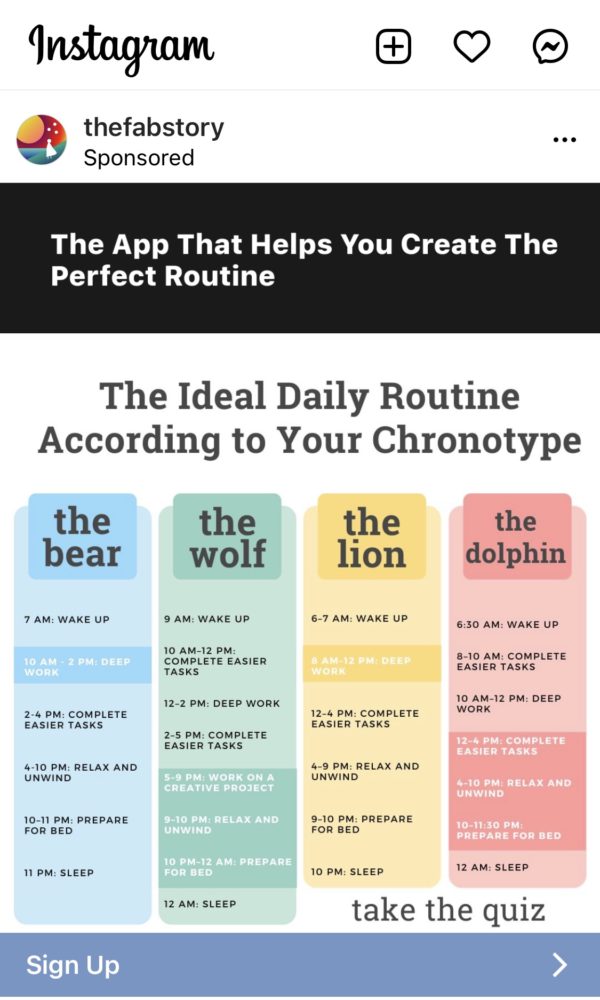
The Fab Story pays to promote its content, like this one about ideal daily routines, on Instagram.
Why it works
The sheer volume of activity on most social channels means it’s difficult to get into your target audience’s feeds, let alone grab their attention without some paid support.
Social media platforms also continually refine and expand their paid opportunities, so it’s a good idea to stay on top of the latest options.
#SociaMedia platforms continually refine and expand their paid opportunities, so it’s a good idea to stay on top of the latest options, says @joderama via @CMIContent. Click To Tweet
How to work it
Detailing every social channel’s paid promotion offerings is a Herculean task that would far exceed the scope of a single article. But fear not: To help you pursue their common opportunities from a more informed standpoint, I compiled this summary:

Pitchfork uses Facebook to promote a timely story about the death of Foo Fighters drummer Taylor Hawkins.
Image source: Facebook Stories
Facebook is at a bit of a crossroads given Apple’s iOS privacy changes and a recent study that its ad targeting around user interests may be inaccurate 30% of the time. In response, parent company Meta plans to remove some ad targeting options to reduce the potential for abuse.
Yet, Facebook’s multiple formats, configurations, and distribution efforts still make it a robust and impactful choice for content promotion. Here are the core options:
- Pins: Post and pin a piece of content on your business page to keep it at the top of the timeline. It’s the first thing users see when they visit your page. It’s also free and easy to do for page admins or editors. The pin expires in seven days, which makes it great for adding a little oomph to a piece of content getting good traffic on your owned media channels.
- Boosts: Pay to extend the reach of an organic post, Story, or Reel beyond the people who liked your page and receive your content in their news feeds. This technique allows segmentation based on age, location, lifestyle interests, and more.
- Ads: Promote content the same way you might advertise a product or service. You can place simple text- and image-based ads that feature content you posted on Facebook. Configure link ads for Stories and Reels that go to a designated landing page or lead form. You can get more creative with in-stream video ads, carousels (a single ad displaying multiple images or videos), or Instant Experience ads – interactive multimedia showpieces optimized for full-screen mobile viewing.
Ad campaigns are configured through Meta’s Ads Manager interface – an auction-based system, which enables you to set a budget and maximum bid amount, choose goals and audience-targeting details, integrate creative assets, and deploy the ad across Facebook, Instagram, and Messenger. The campaigns also can work across third-party apps and websites in Facebook’s Audience Network program.
Brands on Facebook also have the option to manage both their page content and their ad campaigns through Meta Business Suite – a centralized set of tools for business users.
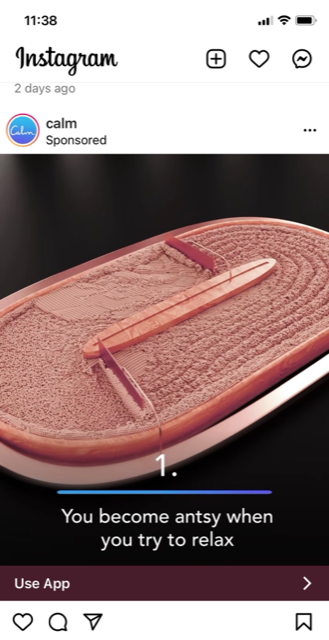
This Instagram display ad for mindfulness app Calm incorporates a soothing visual well-aligned with the benefits users associate with the brand’s content.
Like its Meta-sister site Facebook, Instagram lets you pay to boost content published on your brand’s profile page, as well as buy display ads to run in content feeds. In addition, you can place both display and video ads to run in Instagram Stories. These ads appear in between the image- and video-centric Stories.
It recently added a paid influencer option – the Instagram Creators program. It helps your brand match and engage with influential creators to amplify your existing content from their handles or co-create original branded content for Reels.
TIP: Paid advertising can only be done through a professional account equipped with Meta Ad manager. For boosted posts, it’s helpful (but no longer required) to create a Meta ad account or link your Instagram account to a Facebook page on which you are a page admin. This makes it easier to create and manage ads across platforms using the same set of tools.
Create a @Meta ad account to make it easier to create and manage #Facebook and #Instagram ads using the same set of tools, says @joderama via @CMIContent. Click To Tweet
HANDPICKED RELATED CONTENT:
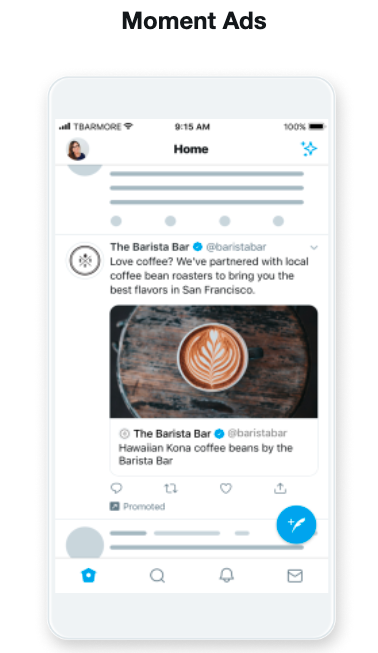
Twitter Moment ads like this one from The Barista Bar can be used to drive users to your product pages, as well as to explore relevant content offered on your website.
Over the past few years, Twitter has considerably evolved its content promotion offerings. While you can still link to and embed content assets for free, adding a bit of budget to the equation gives you more creative flexibility.
Its promoted ads campaign lets you pay to amplify regular tweets or video content embedded in a tweet. You can also leverage Moment Ads – creating, curating, and promoting a collection of tweets to tell an immersive story beyond 280 characters.
Other paid promo options include native text ads, carousel ads (promote more than one content asset within a scrolling unit), Twitter Live (broadcast your best streaming content), and Branded Notifications (create automated @-mention tweets to create one-to-one conversations around your content at scale.)
Its newest feature – Twitter Spaces – may be its most exciting content promotion opportunity. These livestreaming collaborative audio conversations (similar to Clubhouse) deliver an event-like experience, making it an organic (and free) opportunity to weave a mention of your content into your topical discussions. Even more intriguing: Participants don’t need a Twitter account to listen to your Spaces conversations.
@Twitter’s newest feature @TwitterSpaces may be its most exciting #content promotion opportunity. And it’s free, says @joderama via @CMIContent. Click To Tweet
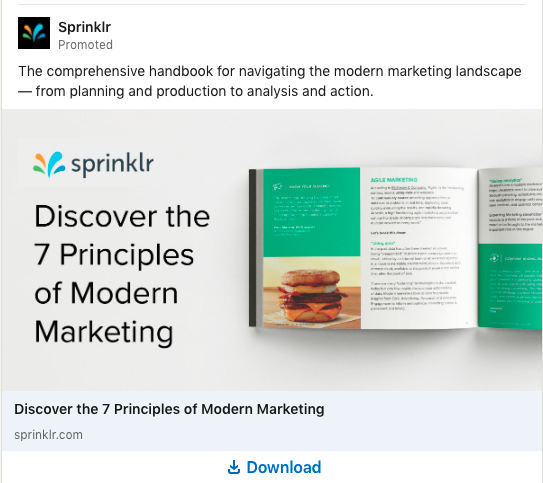
Sprinklr promotes its 7 Principles of Modern Marketing handbook on LinkedIn to enable lead-generation downloads.
Over 800 million business professionals are members of the LinkedIn community, making the platform ideal for brands targeting audiences with a business frame of mind.
LinkedIn offers several paid options for boosting your content’s reach among its members – including those outside your brand’s network and communities.
For starters, LinkedIn offers single-image, video, and carousel sponsored content ads that appear on users’ profile pages. There’s also an ad format specifically designed to highlight your brand’s events.
In addition, you can use its proprietary ad platform to set up:
- Direct sponsored content campaigns: These ads don’t appear on your LinkedIn page as an update, but they do provide enhanced lead generation, audience targeting, conversion tracking, and message testing capabilities.
- Messenger ads: Sponsored messaging lets marketers use LinkedIn Messenger to deliver content and a personalized greeting directly to specific users.
- Conversation ads: Start quality conversations with your audience through a direct-message, choose-your-own-path experience.

Ad Outreach pays for a pre-roll ad to promote its YouTube Advertising Masterclass.
Given its parent company is Alphabet – the same as Google’s – promoted content on YouTube can be managed using the Google Ads interface. Given Google’s overall domination of the advertising landscape, YouTube offers an array of highly configurable ad formats that content marketers will find helpful. Options include:
- In-stream ads (skippable and non-skippable): These ads run before, during, or after videos on YouTube and across websites and apps running on Google video partners.
- In-feed video ads: These ads promote content in YouTube’s discovery features – adjacent to related video recommendations, search results, or the YouTube home page.
- Bumper ads: Similar to in-stream ad placements, bumper ads are six seconds or less and can’t be skipped.
- Outstream ads: These mobile ads only appear on websites and apps running on Google video partners.
- Masthead ads: These ads automatically play without sound for up to 30 seconds at the top of the YouTube home feed. You can only purchase these by contacting a Google sales rep.
To drive increased engagement to any of these formats, consider adding interactive features to your ads. Options available through Google Ads include;
- End screens: At the end of your video ad, show an automatically generated screen that encourages viewers to take action.
- Call-to-action button: Entice viewers to visit your site by clicking on a call-to-action button.
- Extensions: Provide more information about your business, such as a link to parts of your website or a lead form for people to submit their contact information.
- Product feeds from Merchant Center: Turn your video ads into a virtual storefront with an interactive product feed.
- Related videos: Show a list of related videos when your video ad plays on YouTube.
If you’re working with YouTube Studio, you can use the Cards feature, which lets you showcase elements described in your content, as well as promote other videos or playlists to generate engagement for your channel.
@legendaryhbomax Yasss, darling! The House of Escada is OVAH. #LegendaryChallenge ♬ Legendary – MikeQ & Ash B.
HBO promoted its #LegendaryChallenge on TikTok’s Discover page, which helped boost brand awareness and recall.
Content promotions on TikTok may not rival the reach of Meta’s vast network of partner sites or Google’s dual dominion of search and video – yet. The platform’s popularity is growing, and an estimated 1 billion active monthly users spend an average of 38 minutes per day on the platform.
As you’d expect, TikTok’s paid promotion options are video-focused, including in-feed ads and TopView spots – billboard-like videos that play when the user first opens their app. But TikTok also allows the addition of branded effects, including interactive elements that can deepen user engagement.
Alternately, you can build a Branded Hashtag Challenge around your content, like HBO did to promote the launch of its original series, Legendary.
Given TikTok’s popularity with the creator set, it’s a great place to shop around for your next influencer partnership. Its Creator Marketplace is a helpful tool to do that.
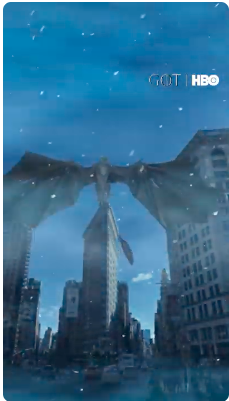
HBO created this dynamic video spot for use on Snapchat.
Though the Snapchat audience isn’t what it used to be, it’s still a viable engagement platform, especially for brands looking to connect with audiences in their teens and early 20s.
To keep up with its bigger social sisters, Snapchat has expanded its promotions offerings in the past several years. It offers single-image and single-video Snap Ads. Brands also can stitch up to 20 image/video ads into a Story Ad, which gets delivered in between content or through a branded tile in Snapchat’s Discover section.
TIP: Snapchat’s signature filters and lenses can be tempting to use, but they may not be your best option given the entertainment-focused and highly personal nature of the typical Snapchat conversation.
Additional paid content promotion tips
Regardless of format or platform, the ultimate goal of paid promotion should be to drive audiences to your website, blog, or other owned media channels. Here are some best practices to increase your chances of making that happen:
- Know your goals and target audience: Most paid promotion solutions provide some form of audience segmentation – helping you get your content in front of the right consumers, not just more. You need a clear view of who those consumers are and what you want them, or you won’t be able to configure your campaigns to achieve those goals.
- Put your best content forward: In general, focus on amplifying content assets already performing well organically – i.e., ranking well on search, earning above-average page views, or achieving strong conversion rates. You can focus your energy on optimizing their ad messages and placements rather than identifying content worthy of promotion.
- Research your keywords for paid search: Look to include relevant terms that receive a decent amount of search traffic but aren’t too competitive, especially when working with auction-based placements.
- Craft your creative thoughtfully: Creative real estate is often limited in paid promotion spots, so get to the point quickly and compellingly. The text and images should work cohesively to communicate the value your content offers. Don’t forget to include a clear call to action, so your audience members know what to expect once they click.
- Optimize your landing pages: Speaking of clicking, ensure that once the users arrive on your site, they find a worthwhile experience. Make it easy for them to access the content promoted in your ad and provide a clear navigational path to help them discover additional, contextually relevant content.
- Take advantage of retargeting capabilities: As Aaron Agius points out, craft your PPC campaigns to retarget people who have expressed an interest in your brand’s content but failed to take action the first time around. With Facebook, for example, you can add a Meta pixel (a small line of code inserted into your site pages) to accomplish this. (Note: Apple’s iOS14 changes will affect those tracking capabilities, so it’s a good idea to read up on those changes here.)
Amplify to achieve
While content marketing is a powerful technique on its own, just imagine what your efforts can achieve with the right paid promotion campaigns working to amplify and expedite your success.
Got a great tip for getting better results from your investment in paid search, social media advertising, native advertising, or influencer marketing? Why not share it with your fellow marketers in the comments?
Cover image by Joseph Kalinowski/Content Marketing institute




